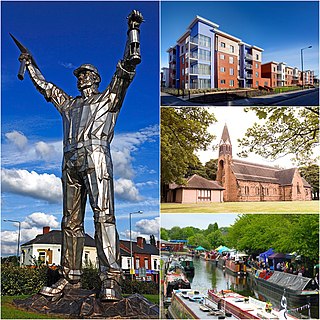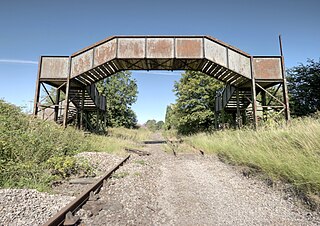
Aldridge is a town in the Walsall borough, West Midlands, England. It is historically a village that was part of Staffordshire until 1974. The town is 3 miles (4.8 km) from Brownhills, 5 miles (8 km) from Walsall, 6 miles (9.7 km) from Sutton Coldfield and 7 miles (11 km) from Lichfield. The town is also the second-largest town in the Walsall Borough.

Brownhills is a town and former administrative centre in the Metropolitan Borough of Walsall, West Midlands, England. A few miles south of Cannock Chase and close to the large Chasewater reservoir, it is 6 miles (9.7 km) northeast of Walsall, a similar distance southwest of Lichfield and 13 miles (20.9 km) miles north-northwest of Birmingham. It is part of the Aldridge-Brownhills parliamentary constituency and neighbours the large suburban villages of Pelsall and Walsall Wood. It lies within the boundaries of the historic county of Staffordshire.

The Cross-City Line is a commuter rail line in the West Midlands region of England. It runs for 32 mi (51 km) from Redditch and Bromsgrove in Worcestershire, its two southern termini, to Lichfield, Staffordshire, its northern terminus, via Birmingham New Street, connecting the suburbs of Birmingham in between. Services are operated by West Midlands Trains.

The Chase Line is a suburban railway line in the West Midlands region of England. It runs from its southern terminus, Birmingham New Street, to Walsall, and then Rugeley in Staffordshire, where it joins the Trent Valley Line. The name of the line refers to Cannock Chase which it runs through at its northern end.

Aston railway station serves the districts of Aston and Nechells in Birmingham, England. The passenger entrance is on Lichfield Road. The station is on the Cross-City Line and the Chase Line. It is one of two local stations for Aston Villa Football Club and near to the Aston Expressway and to Gravelly Hill Interchange.

Lichfield City is one of two railway stations serving the city of Lichfield, in Staffordshire, England. It is situated in the city-centre, and is towards the northern end of the Cross-City Line 17+1⁄4 miles (27.8 km) northeast of Birmingham New Street. The station, and all trains serving it, are operated by West Midlands Railway. The other station serving Lichfield is Lichfield Trent Valley, on the city outskirts.
The South Staffordshire line is a partially mothballed and active former mainline that connects Burton-upon-Trent to Lichfield in Staffordshire and formerly then to the West Midlands towns of Walsall, Wednesbury, Dudley and Stourbridge. However, Dudley and Stourbridge were already joined to the Oxford, Worcester and Wolverhampton Railway's (OW&WR) line just north of Dudley Station. It in essence, continued to Stourbridge along with Wednesbury and Walsall.

The Walsall–Wolverhampton line is a railway line in the West Midlands, England. It connects the town of Walsall to the city of Wolverhampton. The complete line does not currently have any regular scheduled passenger services: The line's local passenger service was withdrawn in 1965, it was restored in 1998, only to be withdrawn again in 2008. At present, the main use of the line is by freight trains, and it is also used as a diversionary route when engineering works are carried out on the West Coast Main Line.

Dudley Railway Station was a railway station in Dudley, West Midlands, England, built where the Oxford-Worcester-Wolverhampton Line and the South Staffordshire Line diverged to Wolverhampton and Walsall and Lichfield respectively.

Brierley Hill railway station was a station on the Oxford-Worcester-Wolverhampton Line serving the town of Brierley Hill in England.

Wednesbury Town railway station was a station on the South Staffordshire Line.

Rushall railway station was a station serving the villages of Blakenall Heath and Rushall in the Metropolitan Borough of Walsall, England. It was on the South Staffordshire Line between Walsall and Lichfield.

Pelsall railway station is a disused railway station that served the villages of Pelsall and Shelfield in the Metropolitan Borough of Walsall, West Midlands, England. It was on the South Staffordshire Line between Walsall and Lichfield.

Hammerwich railway station is a disused station on the South Staffordshire Line. It opened in 1849. It closed as part of the Beeching Axe in January 1965. The station was built and served by the South Staffordshire Railway, which later became London, Midland and Scottish Railway.
The South Staffordshire Railway (SSR) was authorised in 1847 to build a line from Dudley in the West Midlands of England through Walsall and Lichfield to a junction with the Midland Railway on the way to Burton upon Trent, with authorised share capital of £945,000. It was supported by the newly-formed London and North Western Railway (LNWR) and the Midland Railway, giving each company access to important areas. It completed its main line in 1849. As collieries in the Cannock region rose in importance, it built a second main line from Walsall to Rugeley, as well as numerous short spurs and connections to lines it intersected. Colliery working in the Cannock area expanded enormously, and mineral traffic carryings increased in step.

Rushall is a suburb in the Metropolitan Borough of Walsall in the West Midlands, England. It is centred on the main road between Walsall and Lichfield. It is mentioned in the Domesday Book but has mostly developed since the 1920s. Rushall was historically a part of the county of Staffordshire before it was incorporated with much of the old Aldridge-Brownhills Urban District into the modern-day Walsall district.
The Midland Railway branches around Walsall were built to give the Midland Railway independent access to Wolverhampton, and to a colliery district at Brownhills. The Midland Railway had a stake in the South Staffordshire Railway giving it access to Walsall, and the Walsall and Wolverhampton Railway (W&WR) was opened in 1872. At first the W&WR was independent and neutral, but it was acquired by the London and North Western Railway (LNWR), and then sold by that company to the Midland Railway.
Brownhills Watling Street railway station was a station on the Midland Railway in England. It was opened in 1884, closed in March 1930 for passenger use and the track was closed in 1960.

Alrewas railway station was a station on the South Staffordshire Railway, which served the village of Alrewas, Staffordshire. The station was located next to a level crossing, although the main road, now the A513, now crosses the railway line via a bridge.


















